2002: Conference at Wierzba, Poland
Contributions to the 5th International Conference on the black bee
Assegid Garedew, Erik Schmolz, Burkhard Schricker, Benedikt Polaczek, Ingolf Lamprecht
Energy metabolism of Varroa destructor mites and its implication on host vigour.
Aleksandra Langowska, Bożena Szymaś, Antoni Przybył
Utilisation of the seeds of milk thistle (Silybum marianum (L.), Gaertn.) in the nutrition of honey bee.
Jerzy Paleolog
The food storage efficiency and the competition abilities in the Black Bees tested in Poland.
Jaroslaw Prabucki, Bożena Chuda-Mickiewicz
Honey yield of Polish commercial lines of middle European bee (Apis mellifera mellifera L.) and their crossbreeds with other races.
Jaroslaw Prabucki, Jerzy Samborski, Bożena Chuda-Mickiewicz
The use of three taxonomic characters for race identification of middle European bee.
Jerzy Samborski, Jaruslav Prabucki, Bożena Chuda-Mickiewicz, Grzegorz Perużyński
Operation rate and sensitivity of devices used for determining cubital index value.
Balser Fried
Apis mellifera mellifera situation in Switzerland.
Yves Layec
Some aspects of the situation of the Black Bee (Apis mellifera mellifera) in France.
Łucja Skonieczna, Wioletta Naruszewicz
Protection of natural populations of Apis m. mellifera in isolted areas of Augustów old virgin forest and the Kampinos National Park and conservation breeding program of pólnocna (north) line.
Josef A. Stark
Difference in honeybee mortality between four subspecies of the honeybee Apis mellifera L.
Joanna Troszkiewicz
The Polish national conservation programme for the four lines of the Black Bees.
Jerzy Wilde, Janusz Bratkowski, Maciej Siuda
Defensive behavior of 3 breeds of Apis mellifera L.
Jerzy Wilde, Maciej Siuda, Daniel Rykowski, Janusz Bratkowski
Flight activity of 3 subspecies of honeybee Apis mellifera L. depending on time of day and air temperature.
N. J. Drivdal
Border strategy for bee reservation in marginal areas
Zdzislaw Gliński, Marek Chmielewski
The role of haemocytic and humoral immune responses of Apis mellifera mellifera against the background of insect internal immunity.
Czeslaw Korpysa
The use of middle european breed “ASTA” line bees in beekeeping
B. Madras-Majewska, Z. Jasinski, T. Żarski, H. Żarska
The content of mercury in honeybee body and bee products originating from different region of Poland.
B. V. Pedersen
DNA analysis of black honey bees (Apis mellifera mellifera).
D. Pritchard
Bee breeding activities in the United Kingdom
Adam Roman
Field assessment study of selected breeding lines and crossbreeds of the carniolan bee.
K. Romaniuk, W. Witkiewicz
Progress of Varroa destructor invasion in bees, bee and drone brood in colonies wilh augustica, caucassia and carniolan queen.
K. Romaniuk, A. Witkiewicz, W. Witkiewicz
Pollen source of hive environment contamination by radioactive Cs-137.
B. Schricker
Evolution and distribution of the westcrn honeybee Apis mellifera consequences of beekeeping and bee breeding.
Wojciech Skowronek, Jerzy Szymula
Morphological evaluation of native lines of Apis m. mellifera bees using scanning techniques.
J. Wilde, K. Romaniuk, M. Siuda, B. Bąk
Does Varroa destructor Oud. prefer larvae of a particular race of Apis mellifera L.
Zdzislav Wilkaniee, Monika Fliszkiewicz
Apis mellifera L.. in bee-trees.
Jerzy Woyke
Genetic basis of honey bee breeding taking into account local subspecies of Apis m. mellifera.
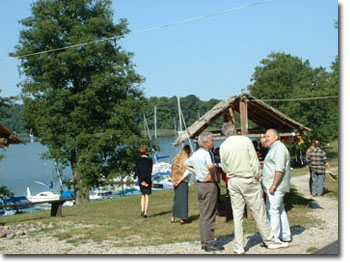
Delegates enjoying the grounds of the conference venue at Wierzba.
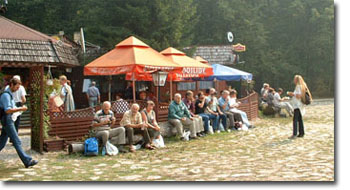
Lunch break on the way to the black bee reserve, Augustów Forest.
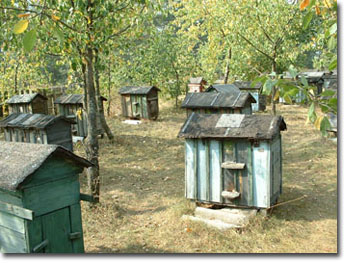
An apiary of traditional Polish trough hives.
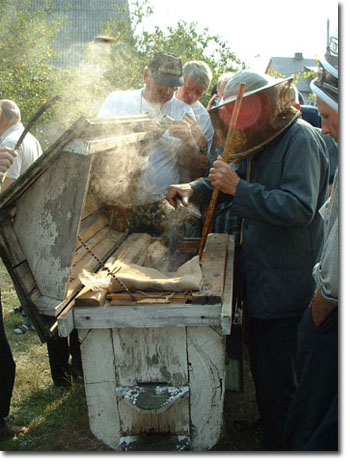
Manipulating a Polish trough hive.
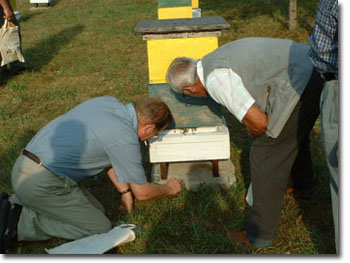
Examining bees at the entrance of a Polish magazine hive, Augustów Forest.
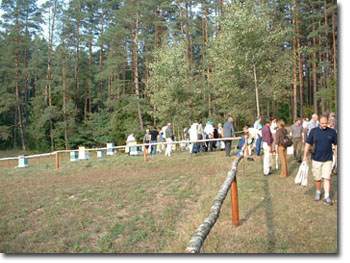
Apiary of magazine hives, Augustów Forest.
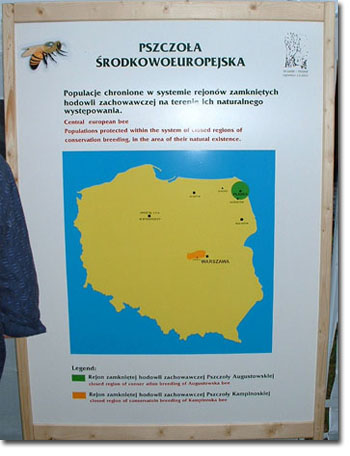
Apiary poster showing map of Poland with black bee reserves.
